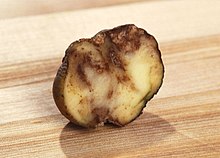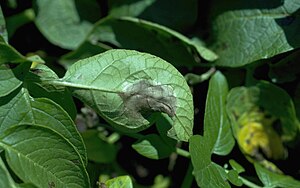Phytophthora infestans
Phytophthora infestans is a water mould, that causes the serious disease of the potato, late blight or potato blight. (Early blight, caused by Alternaria solani, is also often called potato blight). This disease was a major culprit in the causation of the 1847 Irish potato famine and also the Highland potato famine. The organism can also infect tomatoes and some other members of the Solanaceae.
The spores of this water mould overwinter on infected tubers, particularly those that are left in the ground after the previous year's harvest, and are spread rapidly in warm wet conditions when blight can have devastating effects, destroying entire crops.
Spores develop on the leaves, spreading through the crop when temperatures are above 10°C and humidity is over 75% for 2 days or more. Rain can wash spores into the soil where they infect young tubers, or else spores can be blown in from distances of up to miles by the wind.
The early stages of blight are easily missed, and not all plants are affected at once. Symptoms include the appearance of dark blotches on leaf tips and plant stems. White mould will appear under the leaves in humid conditions and the whole plant may quickly collapse. Infected tubers develop grey or dark patches that are reddish brown beneath the skin, and quickly decay to a foul-smelling mush caused by the infestation of secondary soft bacterial rots. Seemingly healthy tubers may rot later when in store.

Up until the 1970s, there was only one type of blight (A1) in the UK, and this was unable to produce resistant spores that could survive the winter. There are now two types (A1 and A2) which can mate and after that produce resistant spores, although the indications so far are that this rarely, if ever, happens in the UK. Mating can occur only between moulds of different mating-types and is required for the production of resistant spores.
Prevention and control of potato blight can be achieved by planting only good quality seeds obtained from certified suppliers. Do not save your own seed for replanting, and try to ensure that no ‘volunteer’ tubers are left in the soil after harvest. Potato varieties vary in their susceptibility to blight. Most early varieties are very prone; so that the crop matures before blight starts (usually in July) plant them early. Maincrop varieties which are very slow to develop blight include Cara, Stirling, Teena, Torridon, Remarka and Romano. Some so-called resistant varieties can resist some strains of the blight and not others, so their performance may vary depending on which are around.
Growing potatoes should be earthed up regularly in order to minimise the risks of spores being washed down into the soil reaching the tubers. If blight symptoms appear, remove all affected leaves immediately. Cut off and burn all foliage in bad cases to help prevent spread to the tubers. Don't harvest the crop for at least 3 weeks. By then, tubers will have thicker skins and blight spores on the surface will have died. A hot compost heap should destroy the spores on the leaves, but it is probably not worth the risk. Any infected tubers should definitely be burned.
The potato blight caused the Irish Potato Famine in 1845-49 which, it is estimated, caused over 1,000,000 to starve death and forced a further 2,000,000 to emigrate.
References
edit- Erwin, Donald C. and Olaf K. Ribeiro. Phytophthora Diseases Worldwide, American Phytopathological Society (1996).
- Lucas, J.A. (editor), R. C. Shattock (editor), D. S. Shaw (editor), Louise Cooke (editor). Phytophthora (British Mycological Society Symposia), Cambridge University Press (1991)
